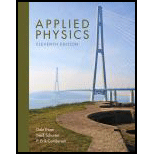
Applied Physics (11th Edition)
11th Edition
ISBN: 9780134159386
Author: Dale Ewen, Neill Schurter, Erik Gundersen
Publisher: PEARSON
expand_more
expand_more
format_list_bulleted
Concept explainers
Textbook Question
Chapter 5, Problem 5RP
Two movers push a piano across a frictionless surface. One pushes with 29.0 N of force and the other mover exerts 35.0 N. What is the total force?
Expert Solution & Answer
Want to see the full answer?
Check out a sample textbook solution
Students have asked these similar questions
A car accelerates from rest and reaches a final speed of 15.0 m/s in 5 s. If the net force acting on the car is 4740 N, what is the car’s mass?
The force on an object isb120 N . And the mass of the object is 12 kg .fine the acceleration of the object ?
A woman exerts a horizontal force of 145 N on a box with a mass of 37.2 kg
If the box doesn't move, what's the magnitude of the static friction force (in N)?
Chapter 5 Solutions
Applied Physics (11th Edition)
Ch. 5.2 - Find the total force necessary to give each mass...Ch. 5.2 - Find the total force necessary to give each mass...Ch. 5.2 - Find the total force necessary to give each mass...Ch. 5.2 - Find the total force necessary to give each mass...Ch. 5.2 - Find the total force necessary to give each mass...Ch. 5.2 - Find the total force necessary to give each mass...Ch. 5.2 - Find the total force necessary to give each mass...Ch. 5.2 - Find the total force necessary to give each mass...Ch. 5.2 - Find the acceleration of each mass with the given...Ch. 5.2 - Find the acceleration of each mass with the given...
Ch. 5.2 - Find the acceleration of each mass with the given...Ch. 5.2 - Find the acceleration of each mass with the given...Ch. 5.2 - Find the acceleration of each mass with the given...Ch. 5.2 - Find the acceleration of each mass with the given...Ch. 5.2 - Find the acceleration of each mass with the given...Ch. 5.2 - Find the acceleration of each mass with the given...Ch. 5.2 - Find the acceleration of each mass with the given...Ch. 5.2 - Find the acceleration produced by a total force of...Ch. 5.2 - Find the total force necessary to give an...Ch. 5.2 - Find the total force necessary to give a rocket of...Ch. 5.2 - A forklift has a mass of 975 kg. What force must...Ch. 5.2 - A power wheelbarrow has a mass of 432 kg. What...Ch. 5.2 - What is the rate of deceleration of a 1400-kg SUV...Ch. 5.2 - An earthmover slows from 15.0 km/h to 3.00 km/h in...Ch. 5.2 - Find the total force necessary to give a 140-kg...Ch. 5.2 - Find the acceleration produced by a total force of...Ch. 5.2 - Find the mass of an object with acceleration 15.0...Ch. 5.2 - An automobile has a mass of 100 slugs. The...Ch. 5.2 - Find the acceleration produced by a force of 6.75 ...Ch. 5.2 - An astronaut has a mass of 80.0 kg. His space suit...Ch. 5.2 - A discus thrower exerts a force of 140 N on the...Ch. 5.2 - A scooter and rider together have a mass of 275...Ch. 5.2 - A pickup truck with mass of 1230 kg moving at 105...Ch. 5.3 - Find the weight for each mass. 1. m = 30. 0kgCh. 5.3 - Find the weight for each mass. 2. m = 60.0kgCh. 5.3 - Find the weight for mass. 3. m = 10.0 slugsCh. 5.3 - Find the weight for each mass. 4. m = 9.00 kgCh. 5.3 - Find the mass for each weight. 5. Fw = 17.0 NCh. 5.3 - Find the mass for each weight. 6. Fm = 21.0 lbCh. 5.3 - Find the mass for each weight. 7. Fw = 12,000 NCh. 5.3 - Find the mass for each weight. 8. Fw = 25, 000 NCh. 5.3 - Find the mass for the each weight. 9. Fw = 6.7 ...Ch. 5.3 - Find the mass for each weight. 10. Fw = 5.5 106...Ch. 5.3 - Find the weight of an 1150-kg automobile.Ch. 5.3 - Find the weight of an 81.5-slug automobile.Ch. 5.3 - Find the mass of a 2750-lb automobile.Ch. 5.3 - What is the mass of a 20,000-N truck?Ch. 5.3 - What is the mass of a 7500-N trailer?Ch. 5.3 - Find the mass of an 11,500-N automobile.Ch. 5.3 - Find the weight of a 1350-kg automobile (a) on the...Ch. 5.3 - Maria weighs 115 lb on the earth. What are her (a)...Ch. 5.3 - Johns mass is 65.0 kg on the earth. What are his...Ch. 5.3 - What is your weight in newtons and in pounds?Ch. 5.3 - What is your mass in kilograms and in slugs?Ch. 5.3 - What are your U.S. mass and weight on the moon?Ch. 5.3 - What are your metric mass and weight on the moon?Ch. 5.3 - Johns mass is 65.0 kg on the earth. What are his...Ch. 5.3 - Maria weighs 115 lb on the earth. What are her U...Ch. 5.3 - John's mass is 65.0 kg on the earth. What are his...Ch. 5.3 - What are your metric mass and weight on Jupiter,...Ch. 5.3 - What are your metric mass and weight on Mars,...Ch. 5.3 - An automobile transmission weighs 995 N. What is...Ch. 5.3 - A power wheelbarrow weighs 210 N. What is its...Ch. 5.4 - A cart on wheels weighs 2400 N. The coefficient of...Ch. 5.4 - A wooden crate weighs 780 lb. What force is needed...Ch. 5.4 - A piano weighs 4700 N. What force is needed to...Ch. 5.4 - A force of 850 N is needed to keep the piano in...Ch. 5.4 - A dog sled weighing 750 lb is pulled over level...Ch. 5.4 - A horizontal conveyor belt system has a...Ch. 5.4 - A tow truck can deliver 2500 lb of pulling force....Ch. 5.4 - A snowmobile is pulling a large sled across a...Ch. 5.4 - An automobile weighs 12,000 N and has a...Ch. 5.4 - A light truck weighs 14,000 N with a coefficient...Ch. 5.4 - A stake truck weighs 20,000 N with a coefficient...Ch. 5.4 - An alloy block is placed on a smooth composite...Ch. 5.4 - If a 20.0-N casting is placed on the block in...Ch. 5.4 - Rubber tires and wet blacktop have a coefficient...Ch. 5.4 - The coefficient of friction in Problem 15 is 0.700...Ch. 5.5 - Find the net force including its direction when...Ch. 5.5 - Find the net force including its direction when...Ch. 5.5 - Find the net force including its direction when...Ch. 5.5 - Find the net force including its direction when...Ch. 5.5 - Find the net force including its direction when...Ch. 5.5 - Find the net force including its direction when...Ch. 5.5 - Find the acceleration of an automobile of mass 100...Ch. 5.5 - Find the acceleration of an automobile of mass...Ch. 5.5 - A truck of mass 13,100 kg is acted upon by a...Ch. 5.5 - A speedboat of mass 30.0 slugs has a 300-lb force...Ch. 5.5 - A truck with a mass of 14,000 kg is pushed with a...Ch. 5.5 - A trailer has a mass of 5000 kg. It is pulled by a...Ch. 5.5 - A refrigeration unit on a job site must be slid...Ch. 5.5 - A light truck of 2000-kg mass has to be pushed...Ch. 5 - Force a. is a vector quantity. b. may be different...Ch. 5 - The metric weight of a 10-lb bag of sugar is...Ch. 5 - Mass and weight a. are the same. b. are different....Ch. 5 - According to Newtons second law, the law of...Ch. 5 - Friction a. always acts parallel to the surface of...Ch. 5 - Cite three examples of forces acting without...Ch. 5 - Using your own words, state Newton's first law,...Ch. 5 - Distinguish between velocity and acceleration.Ch. 5 - When the same force is applied to two different...Ch. 5 - Is 3 lb heavier than 10 N?Ch. 5 - Explain how life would be easier or more difficult...Ch. 5 - Explain how the weight of an astronaut is...Ch. 5 - Explain the difference between action and reaction...Ch. 5 - State Newton's third law of motion, the law of...Ch. 5 - A crate of mass 6.00 kg is moved by a force of...Ch. 5 - An 825-N force is required to pedal a bike with an...Ch. 5 - A block of mass 0.89 slug moves with a force of...Ch. 5 - What is the force necessary for a 2400-kg truck to...Ch. 5 - Two movers push a piano across a frictionless...Ch. 5 - A 340-N box has a frictional force of 57 N. Find...Ch. 5 - A truck pulls a trailer with a frictional force of...Ch. 5 - A steel box is slid along a steel surface. It has...Ch. 5 - A rock of a mass 13.0 kg is dropped from a cliff....Ch. 5 - A projectile has a mass of 0 37 slug. Find its...Ch. 5 - What force is required to produce an acceleration...Ch. 5 - Find the total force necessary to give a 280-kg...Ch. 5 - A force of 175 N is needed to keep a 640 -N...Ch. 5 - A crated garden tractor weighs 375 N. What force...Ch. 5 - Find the acceleration of a forklift of mass 1400...Ch. 5 - What is the weight of a 375-kg air compressor?Ch. 5 - What is the mass of a 405-N welder?Ch. 5 - What is the mass of a 12.0-N hammer?Ch. 5 - Engineers at Boeing developing specs for their...Ch. 5 - The Apollo spacecrafts were launched toward the...Ch. 5 - Kirsten's mass is 373 slugs. Being the physics fan...Ch. 5 - A motorcycle racer travelling at 145 km/h loses...Ch. 5 - The motorcycle and rider are sliding with the same...
Additional Science Textbook Solutions
Find more solutions based on key concepts
Express the unit vectors in terms of (that is, derive Eq. 1.64). Check your answers several ways Also work o...
Introduction to Electrodynamics
A 12.0-V battery-operated bottle warmer heats 50.0 g of glass, 2.50102 g of baby formula, and 2.00102 g of alum...
University Physics Volume 2
Rooms A and B are the same size, and are connected by an open door. Room A, however, is warmer (perhaps because...
An Introduction to Thermal Physics
Human moment of inertia. The moment of inertia of the human body about an axis through its center of mass is im...
College Physics (10th Edition)
1. If a particle’s speed increases by a factor of 3, by what factor does its kinetic energy change?
Physics for Scientists and Engineers: A Strategic Approach, Vol. 1 (Chs 1-21) (4th Edition)
8. Josh is climbing up a steep 34° slope, moving at a steady 0.75 m/s along the ground. How many meters of elev...
College Physics: A Strategic Approach (4th Edition)
Knowledge Booster
Learn more about
Need a deep-dive on the concept behind this application? Look no further. Learn more about this topic, physics and related others by exploring similar questions and additional content below.Similar questions
- If a free falling rock hits the ground with a force of 245 Newton, what is its mass ?arrow_forwardA box is being pushed across a tiled floor with a force of 350 N. If the friction force between the box and the florr is 140 N, what is the magnitude of the net force on the box?arrow_forwardIf the seat and person weighs 1130N, what is the tension of the cables?arrow_forward
- A vendor pulls a 250 N cart filled with pop cases so that it rolls along a level floor where the force of friction is 43 N. If the worker exerts a force of 80 N @ 25⁰ on the handle of the cart, what is the acceleration of the cart?arrow_forwardWhat is the force if the mass of an object is 465 kg and its acceleration is 22 m / s to the second powerarrow_forwardA 300 lb car travelling with a speed of 30 mph, strikes an obstruction and is brought to rest in 0.10 sec. What is the average force on the car? The correct answer is 41,000 lbsarrow_forward
- A horizontal force of 130 N is applied to a stationary wooden box in one direction, and a 810 N horizontal force is applied in the opposite direction. What additional force (in N) is needed for the box to remain stationary.arrow_forwardThe mass of a large truck is 80670 lbs. How much force would be required to accelerate the car at a rate of 9 m/sec2?arrow_forwarda car with mass 850kg is moving in the right direction at a constant speed of 1.44m/s.what is the force on the car?arrow_forward
arrow_back_ios
SEE MORE QUESTIONS
arrow_forward_ios
Recommended textbooks for you
 College PhysicsPhysicsISBN:9781305952300Author:Raymond A. Serway, Chris VuillePublisher:Cengage Learning
College PhysicsPhysicsISBN:9781305952300Author:Raymond A. Serway, Chris VuillePublisher:Cengage Learning University Physics (14th Edition)PhysicsISBN:9780133969290Author:Hugh D. Young, Roger A. FreedmanPublisher:PEARSON
University Physics (14th Edition)PhysicsISBN:9780133969290Author:Hugh D. Young, Roger A. FreedmanPublisher:PEARSON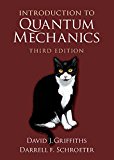 Introduction To Quantum MechanicsPhysicsISBN:9781107189638Author:Griffiths, David J., Schroeter, Darrell F.Publisher:Cambridge University Press
Introduction To Quantum MechanicsPhysicsISBN:9781107189638Author:Griffiths, David J., Schroeter, Darrell F.Publisher:Cambridge University Press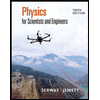 Physics for Scientists and EngineersPhysicsISBN:9781337553278Author:Raymond A. Serway, John W. JewettPublisher:Cengage Learning
Physics for Scientists and EngineersPhysicsISBN:9781337553278Author:Raymond A. Serway, John W. JewettPublisher:Cengage Learning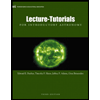 Lecture- Tutorials for Introductory AstronomyPhysicsISBN:9780321820464Author:Edward E. Prather, Tim P. Slater, Jeff P. Adams, Gina BrissendenPublisher:Addison-Wesley
Lecture- Tutorials for Introductory AstronomyPhysicsISBN:9780321820464Author:Edward E. Prather, Tim P. Slater, Jeff P. Adams, Gina BrissendenPublisher:Addison-Wesley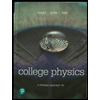 College Physics: A Strategic Approach (4th Editio...PhysicsISBN:9780134609034Author:Randall D. Knight (Professor Emeritus), Brian Jones, Stuart FieldPublisher:PEARSON
College Physics: A Strategic Approach (4th Editio...PhysicsISBN:9780134609034Author:Randall D. Knight (Professor Emeritus), Brian Jones, Stuart FieldPublisher:PEARSON

College Physics
Physics
ISBN:9781305952300
Author:Raymond A. Serway, Chris Vuille
Publisher:Cengage Learning

University Physics (14th Edition)
Physics
ISBN:9780133969290
Author:Hugh D. Young, Roger A. Freedman
Publisher:PEARSON

Introduction To Quantum Mechanics
Physics
ISBN:9781107189638
Author:Griffiths, David J., Schroeter, Darrell F.
Publisher:Cambridge University Press

Physics for Scientists and Engineers
Physics
ISBN:9781337553278
Author:Raymond A. Serway, John W. Jewett
Publisher:Cengage Learning

Lecture- Tutorials for Introductory Astronomy
Physics
ISBN:9780321820464
Author:Edward E. Prather, Tim P. Slater, Jeff P. Adams, Gina Brissenden
Publisher:Addison-Wesley

College Physics: A Strategic Approach (4th Editio...
Physics
ISBN:9780134609034
Author:Randall D. Knight (Professor Emeritus), Brian Jones, Stuart Field
Publisher:PEARSON
Newton's First Law of Motion: Mass and Inertia; Author: Professor Dave explains;https://www.youtube.com/watch?v=1XSyyjcEHo0;License: Standard YouTube License, CC-BY